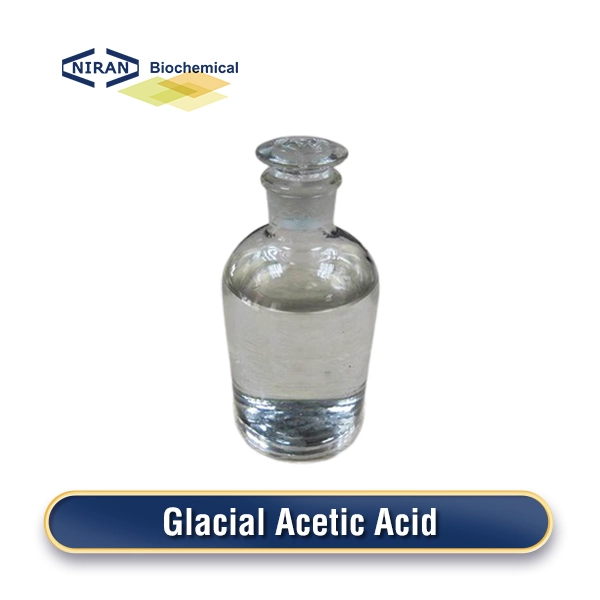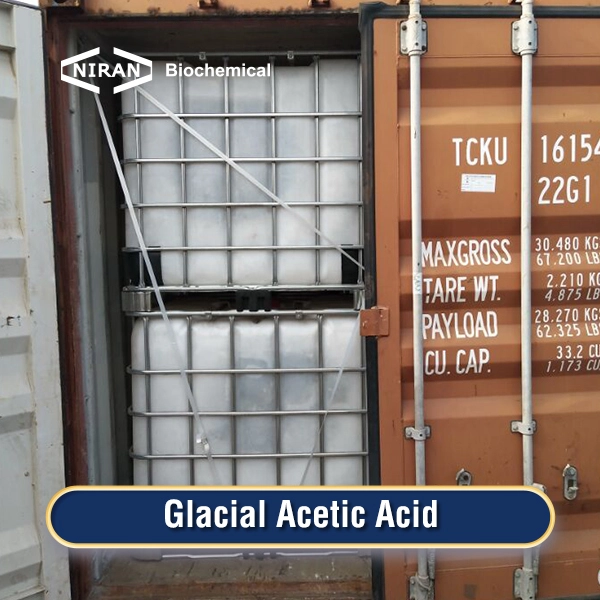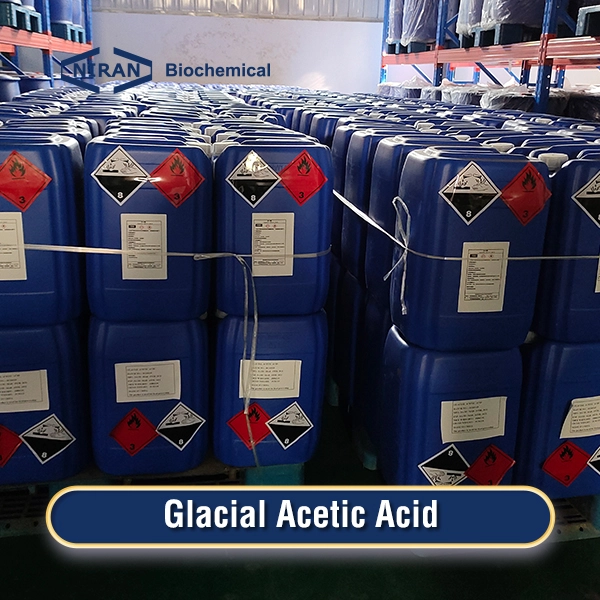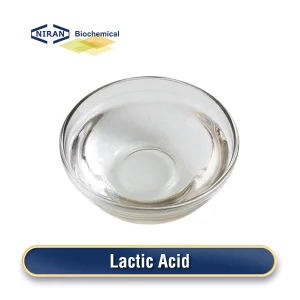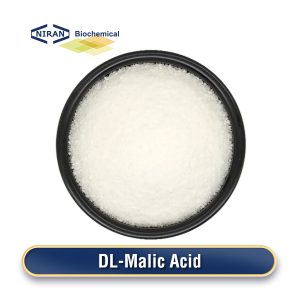Niran Biochemical
YOUR RELIABLE FOOD INGREDIENTS
Send Inquiry
Home » Products » Acidulants » Glacial Acetic Acid-Food Grade
Glacial Acetic Acid-Food Grade
- CAS: 64-19-7
- Chemical Formula: CH3COOH
- Certification: KOSHER, ISO, HALAL, FSSC22000, BRC, etc.
- Standard:
- MOQ: 5MT
- Shelf Life: 2 Years
Inquire Product
Product Description
What is Glacial Acetic Acid-Food Grade?
Glacial Acetic Acid-Food Grade is specially processed and purified to meet food safety standards. It appears as a colorless or white transparent liquid. It can solidify into crystals at low temperatures and has a distinct pungent odor. It can be used as food additive, acidulant, etc.
Glacial Acetic Acid-Food Grade is mainly produced in the following two ways
1. Made from ethanol produced by fermentation
Acetic acid fermentation goes through three stages. First, under the action of enzymes, starch substances in the raw materials are hydrolyzed into sugars. Second, under the action of yeast, sugars are converted into alcohol. These two stages usually occur at the same time, so these two stages are generally referred to as the alcohol fermentation stage. Third, under the action of acetic acid bacteria, alcohol is converted into acetic acid, which is generally the fermentation method of edible vinegar. It has a high degree of naturalness, but the acetic acid concentration is not high, and it is very safe.
The basic process of fermenting acetic acid in modern food industry is to use ethanol produced by fermentation as raw material and then produce food-grade glacial acetic acid through oxidation. The natural degree is above 98, the acetic acid concentration is also above 99.5%, and the safety is relatively high.
2.It is produced by low-pressure carbonylation method, using methanol and carbon monoxide as raw materials.
It uses industrial methanol as raw material, and produces glacial acetic acid with carbon monoxide under low pressure carbonylation, and then obtains food-grade glacial acetic acid (carbonylation method) through subsequent purification. In fact, this method is also the basic production process of industrial glacial acetic acid, but after a relatively rigorous purification process, industrial acetic acid is converted into usable acetic acid, so purification occupies a very important position in this process. Different degrees of purification result in different product quality and product yield.
Related parameters:
| Test Item | Specification | Results |
| Appearance | Colorless | Pass Test |
| Status | Liquid | Pass Test |
| Odor | Strong pungent vinegar | Pass Test |
| Acetic acid content w/% | 99.97 | |
| Potassium Permanganate Test | Pass Test | Pass Test |
| Evaporation residues w/% | ≥99.8 | 0.001 |
| Freezing point(°C) | ≤0.005 | 16.3 |
| Heavy metal(Pb mg/kg) | ≥16.2 | <2 |
| As(mg/kg) | ≥2 | <0.01 |
| Conclusion | ≤1.0 | Qualified |
Recommended dosage (Recommended dose for some applications)
| Food name | Maximum usage(g/kg) |
| Modified milk | 0.01-0.1g/kg |
| Frozen drinks | 0.01-0.1g/kg |
| Canned fruit | 0.5-2g/kg |
| Fruit cakes | 1-5g/kg |
| Bean products | 1-5g/kg |
| Processed nuts and seeds | 1-5g/kg |
| Candy | 2-5g/kg |
| Starches and starch products | 1-5g/kg |
| Bakery products | 1-5g/kg |
| Complex seasonings | 2-5g/kg |
| Carbonated beverages | 1-5g/kg |
Glacial Acetic Acid-Food Grade has a wide range of uses
1. Food flavoring agent and preservative
Glacial acetic acid can not only be used to make vinegar, add sourness and umami flavor to food and improve the taste of food, but also inhibit the growth of bacteria and fungi and extend the shelf life of food.
2. Cleaning purposes
Glacial acetic acid has a good cleaning and decontamination effect. Glacial acetic acid has a good cleaning and decontamination effect. It is one of the main ingredients of cleaning agents and is widely used for cleaning purposes such as cleaning furniture and removing scale.
4. Herbicide
Glacial acetic acid can be used as a herbicide to avoid the use of chemical pesticides and protect the environment. It can be used in flower beds, gardening and agriculture.
5. Medical treatment
Glacial acetic acid has certain applications in medicine, such as for the treatment of onychomycosis, plantar warts, hand and foot hyperhidrosis, etc.
User asked question:
Q: What is the difference between industrial-grade and edible-grade glacial acetic acid?
A: The difference between industrial-grade glacial acetic acid and edible-grade glacial acetic acid lies mainly in the ingredients and production process. Industrial-grade glacial acetic acid usually contains more chlorides and sulfates, while edible-grade glacial acetic acid contains more acetic acid. In addition, the production process of industrial-grade glacial acetic acid is simpler and the cost is lower.
Q: Storage requirements for acetic acid
A: 1. Storage temperature: Glacial acetic acid should be stored in a light-proof, dry, and well-ventilated place. The storage temperature should be below 30°C, and avoid high temperatures and exposure to the sun and rain.
2. Choose the container: You can choose corrosion-resistant glass or plastic containers. They must be sealed and leak-proof.
3. Moisture-proof: Glacial acetic acid easily absorbs moisture, so it should be stored in a dry environment and the container should be kept sealed.
4. Avoid light: Glacial acetic acid is easily photolyzed, so it should be placed in a light-proof place and can be covered with a paper box or cloth.

